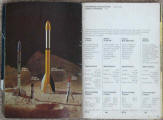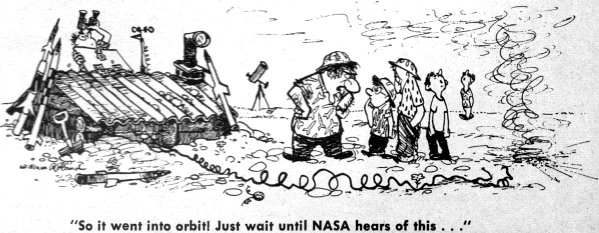|
Harry (aka "Old Rocketeer") Stein
wrote a monthly column for American Modeler back in the
1960s that covered a variety of topics ranging including model rocket
contesting, model rocket building and trimming for flight, recovery
systems, and even a little rocket scientist theory when appropriate.
This particular article discusses getting started in model rocketry
with using the diminutive Astron (Estes) Scout rocket which used
a low-tech tumble recovery system. With the Space Age in full swing
by that
 time,
youths and adults around the world were anxious to get involved.
It was an exciting time for everyone. My own foray into model rocketry
began in the late 1960s during the Apollo program's moon missions.
By then, American Modeler had become American Aircraft
Modeler and Mr. Stein no longer wrote his column, so I never
read one until a few years ago when I began collecting vintage aircraft
modeling magazines for posting here on Airplanes and Rockets. time,
youths and adults around the world were anxious to get involved.
It was an exciting time for everyone. My own foray into model rocketry
began in the late 1960s during the Apollo program's moon missions.
By then, American Modeler had become American Aircraft
Modeler and Mr. Stein no longer wrote his column, so I never
read one until a few years ago when I began collecting vintage aircraft
modeling magazines for posting here on Airplanes and Rockets.
Rocket Trails
by Harry (Old Rocketeer) Stine
How To Get Started In Model Rocketry
 Show
me a fellow with soul so dead who never to himself hath said, "I'd
like to fly a rocket." This is a symptom of a contagious disease
prevalent in many civilized nations of the world. It can be fatal
if the afflicted person starts off by trying to mix his own rocket
propellants. However, if the patient chooses to buy his rocket engines
from a reputable manufacturer, it means that he has contracted a
non-lethal form of the rocket disease and can be well on his way
to having the time of his life. The non-lethal form, called "model
rocketry," is lots of fun. Show
me a fellow with soul so dead who never to himself hath said, "I'd
like to fly a rocket." This is a symptom of a contagious disease
prevalent in many civilized nations of the world. It can be fatal
if the afflicted person starts off by trying to mix his own rocket
propellants. However, if the patient chooses to buy his rocket engines
from a reputable manufacturer, it means that he has contracted a
non-lethal form of the rocket disease and can be well on his way
to having the time of his life. The non-lethal form, called "model
rocketry," is lots of fun.
The critical stage of the disease occurs within the first few
weeks. It involves confusion on the part of the patient in the form
of, "Where do I get stuff? How do I get started?"
Chances are that you will not find any model rocket equipment
in your local hobby store. The customer demand for model rocket
stuff isn't that great - yet, few dealers stock kits, engines, and
equipment. But while you're there in the hobby store, pick up some
dope, glue, an X-acto knife, and some sandpaper ... you'll need
it later.
So the majority of model rocket equipment is sold by the manufacturers.
If you want to get into model rocketry, you'll have to do it by
mail.
At last count there were seven model rocket kits and nearly 24
different types of model rocket engines available. I am going to
suggest specific products here to get you started right.
Besides tools and about five dollars, you are going to need (A)
model rocket, (B) model rocket engines, and (C) launching equipment.
There happens to be a combination of these three for five dollars
that will start you into model rocketry. All are sold by Estes Industries,
Inc., Box 227, Penrose, Colorado. For two bucks, you can get the
Estes "Astron Scout" kit and three engines. The Astron Scout is
a fine little bird with splendid performance. In fact, you won't
believe it until you've seen it. Fairly simple to put together,
it takes about four hours. The kit doesn't look like much when you
get it in the mail, but it contains good quality materials, is well-engineered,
flies reliably, and will go out of sight. It comes with proper instructions
and a technical report on rocket stability.
For his Astron Scout Vern Estes makes a very good model rocket
engine. In fact, he turns out more engines than any other manufacturer.
Estes engines all have the NAR Safety Certificate, which means that
they've been checked carefully by the testing committee of the NAR
and have proven themselves to be reliable and safe if handled according
to instructions. Uncle Sam allows these engines to be shipped through
the mail, which should tell you that they won't blow up.
For two dollars, you've got a model rocket and three engines.
This allows you to fly the Astron Scout three times. If you buy
more engines from Vern, you can keep on flying the Scout indefinitely
just like a model airplane. Estes' NAR Type 1/2 A8-4 powerplant
will put your Astron Scout about 400 feet up. Using Type A8-4, the
model will do about 800 feet. With the super Type B8-6 engine, an
Astron Scout has never been tracked ... but the NAR boys know it
will do better than 1,000 feet.
Because of the Astron Scout's unique recovery system, you can
fly it nearly anywhere. It kicks its engine back and becomes unstable
when it gets to peak altitude. It comes back from the blue end-over-end
like a falling leaf. With no parachute to hang up in trees, it goes
right on through trees to the ground, where you pick it up and get
it ready to fly again.
To fly the Astron Scout - or any other model rocket you may make
in the future - you must have a launching system. Unless you belong
to an organized NAR group that already uses these things, you're
going to have to construct them to fly your birds.
 Estes
makes a dilly of a launching system, the "Electro-Launch," that
sells for $3. It combines a rod launcher with a firing system run
off flashlight batteries. It, too, comes in kit form with excellent
instructions for assembly. It goes together quickly, and you will
learn a great deal about launching systems from it. You'll need
four Size D flashlight batteries, costing you about a buck, to run
the Electro-Launch. The batteries will be good for about 100 launchings.
The Electro-Launch is cheap to operate, and breaks down into handy
pieces small enough to carry around in your tool kit. I have two
of them (although I belong to an NAR Section with complete range
gear) because sometimes I like to go out and fly by myself. Estes
makes a dilly of a launching system, the "Electro-Launch," that
sells for $3. It combines a rod launcher with a firing system run
off flashlight batteries. It, too, comes in kit form with excellent
instructions for assembly. It goes together quickly, and you will
learn a great deal about launching systems from it. You'll need
four Size D flashlight batteries, costing you about a buck, to run
the Electro-Launch. The batteries will be good for about 100 launchings.
The Electro-Launch is cheap to operate, and breaks down into handy
pieces small enough to carry around in your tool kit. I have two
of them (although I belong to an NAR Section with complete range
gear) because sometimes I like to go out and fly by myself.
So now you have laid out five dollars, plus postage, for model
rocket, engines, and launcher, plus another buck for flashlight
batteries. You're ready to fly. Find a football field or a place
where free-flight planes operate. Follow the instructions that come
with the kit and engines. If it doesn't work, go back and read the
instructions again, because you did something wrong. (You must have,
because my 8-year-old daughter built such a model all by herself
that worked fine on the first try.)
Finally, you will count-down, press the ring switch, and marvel.
That collection of paper and balsa on the launcher will come to
life ... and there she goes! Straight up! Look at it go! Joe, did
you see where it went? There it is, tumbling back to the field.
After several flights, you will discover that you have passed the
crisis of the model rocket disease. You have built and flown your
first model rocket. The disease will either abate or get worse.
You've got all the basic equipment to go ahead in the hobby, and
the farther you go the more fun you will have and the more you will
learn. You'll end up with the catalogs from Estes, Model Missiles,
Coaster, and all the rest. You'll be buying body tubes, engines,
nose cones, balsa, dope, and glue, trying new ideas and generally
having a ball. You'll learn that you can build your own models for
less than 50 cents each, when you get good at it. You are now "started,"
and if you have reached this point and want more, you are hooked.
The next thing for you to do is to join the National Association
of Rocketry like every other feverish model rocketeer. Just drop
a post card with your name and address to this magazine. Ye Kindly
Old Editor will see to it that I get it, and you'll get all the
poop from the group right away.
If you do turn out to be a model rocketeer, you'll be into rocketry
quicker, faster, and safer than any other way. It's a whole new
form of modeling ... and you'll know what I mean when I say it's
a disease that all of us rocky-tears suffer from.
Time now for my medicine. All right, nurse, I'm ready ...
Posted March 29, 2014
|